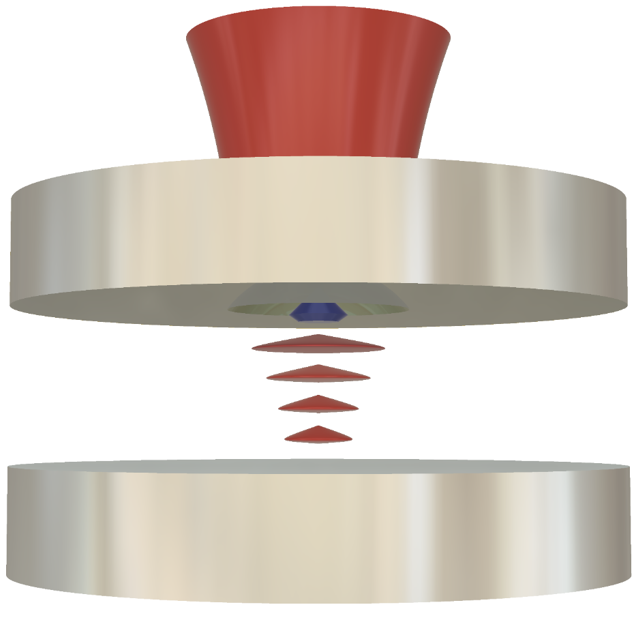Micro Cavities
Overview
Micro-cavities are optical structures designed to trap and manipulate light in tiny volumes. These structures play a crucial role in photonics and have found numerous applications in optical communication, sensing and quantum information processing.
A special type of micro-cavities are hemispherical resonators. A hemispherical resonator traps light in its interior and sustains it over long distances due to total internal reflection at the interfaces of the hemisphere. This results in greatly increased light intensities in a small volume, which is of great interest for many applications.

Experimental Design
In contrast to fiber resonators, this experiment is based on the use of two macroscopic mirrors, which allows a wider choice of resonator structures and thus precise mode-matching to Gaussian optics to optimize light guiding and coupling. The hemispherical (microscopic) structures are fabricated at our CO2 laser experiment and subsequently coated with highly reflective mirrors.
Integration of Color Defect Centers in Diamond
Group IV defects are defects in diamond that are capable of absorbing and emitting light in a wide spectral range. These defects are found in materials belonging to Group IV of the periodic table, which includes silicon (Si) and germanium (Ge). Group IV defects are of great interest for the development of photonic devices due to their optical properties and their integration into established semiconductor technologies.
The combination of micro-cavities with hemispherical resonators and Group IV defects enables the generation of highly localized, highly sensitive optical resonances in these defects. Here are some of the potential applications and benefits of this combination:

Applications
- Quantum information processing: The high-intensity light fields in the resonators make it possible to enhance single-photon interactions with Group IV color centers, which is important for the development of quantum bits (qubits) and quantum communication systems.
- Sensor technology: the strongly enhanced light-material interaction in the resonators can be used to develop highly sensitive sensors for various physical parameters such as temperature, pressure or chemical composition.
- Light source: the combination of hemispherical resonators and Group IV color centers can serve as a light source for optical communication or spectroscopy.
- Optical amplification: By amplifying the light in the resonators, optical amplifiers can be developed that can be used in telecommunications and signal processing.
Tasks on the Experiment
- Optical alignment and handling of highly sensitive microscopic resonators
- Design and improvement of optomechanics for highest stability with high tunability
- Implementation and analysis of color defects in optical resonator(s)
- Upgrades for access to magnetic fields, microwaves and cryogenic environments
- Increasing the efficiency of the system with suitable optics based on simulation
- Programming of software for control and analysis of the system
Openings
We are currently looking for PhD students to join our international team to set up and improve micro-cavity experiments to study color centers in different materials for quantum technologies. We are also looking for bachelor and master students to support us in this work. If you are interested or have any questions, please contact Professor Kubanek.
Publikationen
G. Bayer, R. Berghaus, S. Sachero, A. B. Filipovski, L. Antoniuk, N. Lettner,
R. Waltrich, M. Klotz, P. Maier, V. Agafonov und A. Kubanek. Optical driving, spin initialization and readout of single SiV− centers in a Fabry-Perot resonator. Communications Physics 6.1 (2023): 300.
F. Feuchtmayr, R. Berghaus, S. Sachero, G. Bayer, N. Lettner, R. Waltrich, P. Maier, V. Agafonov and A. Kubanek. Enhanced Spectral Density of a Single Germanium Vacancy Center in a Nanodiamond by Cavity-Integration. Applied Physics Letters 123.2 (2023)



